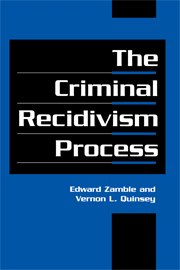Book contents
- Frontmatter
- Contents
- List of Illustrations and Tables
- Preface
- 1 Introduction: The Prediction of Criminal Behavior
- 2 The Study
- 3 Recidivists: A General Profile
- 4 Comparisons with Nonrecidivists
- 5 Comparisons across Offender Groups
- 6 Comparisons within Offender Groups
- 7 Final Considerations
- References
- Appendix: Interview Form
- Index
6 - Comparisons within Offender Groups
Published online by Cambridge University Press: 02 February 2010
- Frontmatter
- Contents
- List of Illustrations and Tables
- Preface
- 1 Introduction: The Prediction of Criminal Behavior
- 2 The Study
- 3 Recidivists: A General Profile
- 4 Comparisons with Nonrecidivists
- 5 Comparisons across Offender Groups
- 6 Comparisons within Offender Groups
- 7 Final Considerations
- References
- Appendix: Interview Form
- Index
Summary
while the design of the study and the selection of subjects were intended to elucidate the precursors of offending according to our trinary division of offence types, many other comparisons of interest may be done. Some of these deal with possible differences within groups, such as comparisons of subtypes of the current offence within groups. These within-group analyses can provide some additional detail on the principal direction of the study and will be presented first in this chapter. Because of the lesser numbers, our sample may not be so statistically sensitive in showing these effects, but the sample sizes are still large enough to test adequately some ideas of theoretical interest.
A great many other analyses are possible with the present dataset, including those that assess the effects of factors other than current psychological functioning. For example, we could evaluate the influence of any included historical measure on offence precursors and process. We have performed a limited set of the possible analyses, chosen because they may help to connect this study to other parts of the literature. The results form the basis of the second half of this chapter.
Among Thieves: Violent versus Nonviolent
In the preceding chapter, we considered evidence for a variety of differences associated with the type of new offence. Given that the comparisons generally neglect the specifics of previous offences, the emergence of a consistent pattern of differences in offence precursors may seem in some ways surprising.
- Type
- Chapter
- Information
- The Criminal Recidivism Process , pp. 119 - 138Publisher: Cambridge University PressPrint publication year: 1997



